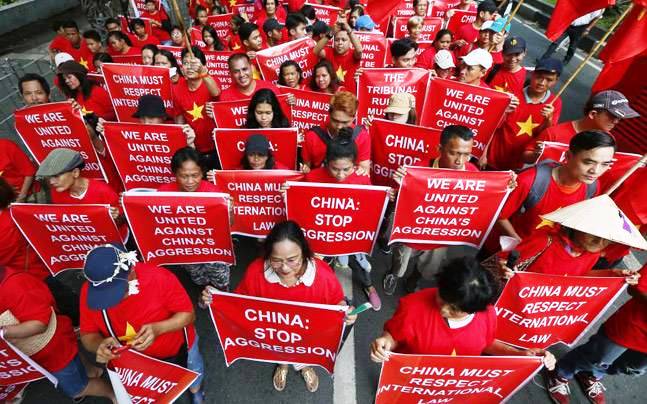China’s ‘salami slicing’: Why Doklam must unite world leaders against Beijing

Indiatodayin
New Delhi, August 4, 2017 | UPDATED 17:28 IST
(Note: China is using Doklam as yet another laboratory to test its sa lami slicing policy of territorial expansion. Oxford Dictionary defines Salami Slicing as the process of gradually reducing the size of something by a series of small incremental steps. China is trying to to do exactly this to India by systematically and relentlessly unleashing a Blitzkrieg of false propanda that Arunachal Pradesh, Sikkim, parts of Himachal Pradesh and now Doklam are disputed areas, and therefore up for grabs. It is also reported to be fomenting the current unrest in Darjeeling, by sending funds through Darjeeling's international border Nepal. China's approach is reminiscent of the propaganda machinery of the Nazi leader Hermann Goering during World War II. India is resisting this attempt while the world leaders have generally maintained silence over Doklam. Only yesterday there was news that Pakistan – read China – is constructing six dams on the Indus river in PoK with China's assistance, Minister of State for External Affairs VK Singh said in a written reply in Rajya Sabha on yesterday. Government has issued demarches to both Islamabad and Beijing over the constructions stating that it is in violation of India's sovereignty and territorial integrity, the Rajya Sabha was informed. "India has a clear and consistent position that these territories are illegally occupied by Pakistan and that any collaborative activity there is in violation of India's sovereignty and territorial integrity," VK Singh said. India has to be constantly on its guard. World leaders should realise that China's increasing aggression is not only a cause for worry for India but for the whole world. Eternal vigilance is the price of liberty. Isaac Gomes, Associate Editor, Church Citizens' Voice).
lami slicing policy of territorial expansion. Oxford Dictionary defines Salami Slicing as the process of gradually reducing the size of something by a series of small incremental steps. China is trying to to do exactly this to India by systematically and relentlessly unleashing a Blitzkrieg of false propanda that Arunachal Pradesh, Sikkim, parts of Himachal Pradesh and now Doklam are disputed areas, and therefore up for grabs. It is also reported to be fomenting the current unrest in Darjeeling, by sending funds through Darjeeling's international border Nepal. China's approach is reminiscent of the propaganda machinery of the Nazi leader Hermann Goering during World War II. India is resisting this attempt while the world leaders have generally maintained silence over Doklam. Only yesterday there was news that Pakistan – read China – is constructing six dams on the Indus river in PoK with China's assistance, Minister of State for External Affairs VK Singh said in a written reply in Rajya Sabha on yesterday. Government has issued demarches to both Islamabad and Beijing over the constructions stating that it is in violation of India's sovereignty and territorial integrity, the Rajya Sabha was informed. "India has a clear and consistent position that these territories are illegally occupied by Pakistan and that any collaborative activity there is in violation of India's sovereignty and territorial integrity," VK Singh said. India has to be constantly on its guard. World leaders should realise that China's increasing aggression is not only a cause for worry for India but for the whole world. Eternal vigilance is the price of liberty. Isaac Gomes, Associate Editor, Church Citizens' Voice).
Commenting on the Doklam standoff between the Indian Army and the People's Liberation Army (PLA), Chinese foreign affairs spokesperson yesterday said, "Right now, I can tell you that there are 48 Indian military guards in our territory of Donglang (Doklam)."
"It has already been more than a month since the incident and India is still not only illegally remaining on Chinese territory, it is also repairing roads in the rear, stocking up supplies, massing a large number of armed personnel," Liu Jinsong said in New Delhi.
This narrative of China is part of a well thought strategy of Beijing to endorse its policy of territorial expansion, which is being met with resistance both in the Himalayan region and the South China Sea. Doklam standoff serves as a warning to world leaders at the neo-colonial ambitions of China.

CHINA'S SALAMI SLICING
Since the birth of Communist China, it is the only country whose boundaries are expanding at the cost of its neighbours. China has been pursuing the expansion policy aggressively along its southern and eastern borders – both territorial and maritime.
Chinese expansion policy has a particular streak. China first stakes claim on its neighbours frontiers forcefully. Beijing repeats its claim at all platforms and on all possible occasions to such an extent that its carefully crafted narrative makes the frontier regions of its neighbours into a dispute or a disputed territory.
International affairs observers have named this Chinese approach of territorial and maritime expansion the 'salami slicing' policy. Doklam is the latest flashpoint of the salami slicing policy of China. While India is resisting Chinese attempt to alter boundaries of its neighbour Bhutan by usurping her land, the world leaders have rather been watching the development with conspicuous silence.
CHINA'S TRACK RECORD
When the Communist Party of China (CPC) unseated the Kuomintang rule in the Han dominated territory of China and drove the former rulers to Taiwan, Tibet was an independent country. It was ruled by Buddhist monks who had no army and were seen as a buffer state by the British Indian rulers.
China set its eyes on Tibet and occupied it militarily claiming that it was part of the country during ancient times. On that logic, India is entitle to lay its claim on Afghanistan, Bangladesh, Pakistan and – as some may argue – even Nepal. The Russia can lay claim on even bigger territory.
Along with Tibet, China also occupied Xinjiang east of Ladakh on the western end of Tibet plateau. The two slices doubled Chinese territorial expanse within years of its establishment.
The next slice was to come from an Indian territory of the size of modern Switzerland – in the form of Aksai Chin. It was the part of the princely state of Jammu and Kashmir. Following its salami slicing policy, China first sent its pastoral communities from Han ethnic group to Aksai Chin with the instruction to drive out local Indian sheep herders.
By 1962, China had announced its claim over Aksai Chin and Arunachal Pradesh. It went to war with India, whose contemporary policy was guided by the Panchsheel and not military prowess. Aksai Chin was cut off.
The Chinese expansion, after meeting resistance from India, has continued in Pakistan. A recent India Today report established how Pakistan has virtually become a colony of China.
EASTWARD EXPANSION
Emboldened by its success in the Himalayas, China replicated the salami slicing policy in the east. It went on to seize Paracel Islands in 1974 from Vietnam. China established Sansha City on the island forcibly acquired from Vietnam.
It was followed by the Johnson Reef which China seized in 1988 from Vietnam. The Mischief Reef in 1995 and the Scarborough Shoal in 2012 were captured in the South China Sea from Philippines.
China has been in a campaign against Japan over the Senkaku Islands, which Beijing calls Diaoyu. It is located in the East China Sea, over which Beijing lays territorial claim. China considers Senkaku as the first chain of islands along with Taiwan and islands in the region controlled by Philippines and Vietnam.
China first laid claim on Senkaku, controlled and administered by Japan. Despite Japan refuting the claims, and the US backing its stand on Senkaku, China kept reiterating its narrative. Now, there is an emerging view that Senkaku Islands are a dispute between China and Japan.
China maintains that it has exclusive territorial (almost 80 per cent of the area) claim over the South China Sea, which is very rich in minerals and natural gas. The US, Japan and the countries having shores in the South China Sea – Taiwan, the Philippines, Malaysia, Brunei, Indonesia, Singapore, and Vietnam – dispute Chinese claim.
The Chinese claim is in violation of the provisions – including that of 200-nautical mile exclusive economic zones – defined in the United Nations Convention on the Law of the Sea (UNCLOS) of 1982. In the face of aggressive salami slicing policy of China, India's stand on Doklam came as flagging example for the world leaders to follow.
















